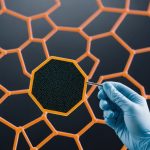Transforming Early Disease Detection: How Graphene-Enhanced Sensors Are Leading the Charge
In the realm of medical diagnostics, the ability to detect diseases early is a game-changer. It can mean the difference between effective treatment and a dire prognosis. Recent advancements in graphene-enhanced sensors are revolutionizing the field of early disease detection, offering unprecedented accuracy, simplicity, and cost-effectiveness. Here’s a deep dive into how these innovative sensors are transforming the landscape of healthcare.
The Limitations of Traditional Methods
Traditionally, diagnosing diseases like kidney disease or cancer has relied on methods that are often invasive, costly, and not always accurate. For instance, kidney health has been monitored by measuring blood creatinine levels, which indicate muscle breakdown. However, creatinine levels can be influenced by a person’s muscle mass and only rise significantly after more than 75% of kidney function is lost[1][2].
Also read : Revolutionizing home building: how 3d printing is redefining custom housing construction
In cancer detection, methods such as biopsies and imaging techniques are commonly used but can be invasive and may not detect cancer cells until they have formed tumors. These limitations highlight the need for more precise and early detection methods.
The Rise of Graphene-Based Biosensors
Graphene, a highly conductive and flexible material, has emerged as a key component in the development of advanced biosensors. Its unique properties make it an ideal material for enhancing the sensitivity and efficiency of biosensors.
This might interest you : Revolutionizing uk manufacturing: how digital twins enhance operational excellence
Graphene Oxide in Biosensors
Graphene oxide (GO) is a derivative of graphene that has been widely used in biosensors due to its simplicity and sensitivity. GO-based biosensors are attractive because they can be easily functionalized with various biomolecules, such as peptides or antibodies, to detect specific biomarkers[3].
For example, a recent study led by Professor Jong Pil Park from Chung-Ang University in the Republic of Korea introduced a biosensor that detects symmetric dimethylarginine (SDMA) levels in urine. SDMA is a more reliable indicator of kidney function than creatinine, as it increases even with mild kidney impairment and is not influenced by muscle mass[1][2].
How Graphene-Enhanced Biosensors Work
The core of these graphene-enhanced biosensors often involves small, linear peptides that specifically bind to the target biomarker. Here’s a detailed look at how these sensors are designed and function:
Design and Fabrication
The biosensor developed by Prof. Park’s team uses a technique called the drop-cast method. Gold electrodes are coated with a solution containing Ni-Cr layered double hydroxide with graphene oxide (NCL-GO) nanostructure. This unique two-dimensional structure consists of Ni-Cr layered double hydroxide nanosheets interconnected with conductive graphene oxide nanosheets. After drying, a stable coating of peptide-functionalized electrodes (peptide/NCL-GO/Au) is formed[1][2].
Enhanced Detection Capabilities
The porous, well-connected networks created by the NCL-GO nanostructure facilitate better charge transfer and molecular diffusion. This enhances the interaction between the peptides and the biomarker (SDMA), boosting the sensor’s detection capabilities. While other methods like chromatography offer higher sensitivity, this electrochemical biosensor is easier to use and does not require advanced equipment, making it more practical and affordable[1][2].
Advantages of Graphene-Based Biosensors
Graphene-based biosensors offer several advantages over traditional detection methods:
Early Detection and Timely Interventions
- Early Detection: These biosensors can detect biomarkers at much lower concentrations, allowing for early detection of diseases. For instance, the SDMA biosensor can detect kidney impairment even when the kidney function loss is as low as 25-40%[1][2].
- Timely Interventions: Early detection enables timely interventions, which can significantly improve treatment outcomes. As Prof. Park notes, “The sensor could facilitate earlier diagnosis, advanced monitoring of kidney function, and improved treatment outcomes for millions of patients worldwide”[1][2].
Cost-Effectiveness and Simplicity
- Cost-Effective: Unlike advanced equipment required for chromatography or other sensitive detection methods, graphene-based biosensors are simpler and more affordable. This makes them practical in many settings, including small clinics and remote locations[1][2].
- Simple Design: The design of these biosensors is straightforward, and they show fast results, making them suitable for regular health check-ups and monitoring[1][2].
Versatility
- Adaptability: The platform technology used in these biosensors has the potential to be adapted for detecting other biomarkers, making it a versatile tool applicable across various areas of healthcare. This versatility opens up possibilities for detecting a wide range of diseases, from cancer to infectious diseases[1][2].
Applications in Cancer Detection
Graphene-based biosensors are also being explored for cancer detection, where early detection is crucial for effective treatment.
Highly Sensitive Detection
- Breast Cancer: For example, graphene-based biosensors can be designed to detect specific biomarkers associated with breast cancer. These sensors can be highly sensitive, allowing for the detection of cancer cells at an early stage when they are more treatable[5].
Real-Time Monitoring
- Real-Time Data: Graphene-based electrochemical biosensors can provide real-time data, enabling continuous monitoring of cancer biomarkers. This real-time monitoring can help in tracking the progression of the disease and the effectiveness of the treatment[5].
Practical Insights and Actionable Advice
Here are some practical insights and actionable advice for those interested in leveraging these advancements:
For Clinicians
- Regular Monitoring: Use graphene-based biosensors for regular health check-ups to monitor kidney function or other biomarkers. This can help in early detection and timely interventions.
- Cost-Effective Solutions: Consider the cost-effectiveness of graphene-based biosensors, especially in resource-limited settings. These sensors can provide accurate results without the need for advanced equipment.
For Patients
- Awareness: Be aware of the new technologies available for early disease detection. Discuss with your healthcare provider the possibility of using graphene-based biosensors for monitoring your health.
- Preventive Care: Emphasize preventive care by opting for regular health check-ups. Early detection can significantly improve treatment outcomes.
Comparative Analysis of Detection Methods
Here is a comparative analysis of traditional detection methods versus graphene-based biosensors:
| Detection Method | Sensitivity | Invasiveness | Cost | Ease of Use | Real-Time Data |
|---|---|---|---|---|---|
| Blood Creatinine | Low | Invasive | High | Complex | No |
| Chromatography | High | Invasive | Very High | Complex | No |
| Graphene-Based Biosensor | High | Non-Invasive | Low | Simple | Yes |
Graphene-enhanced sensors are revolutionizing the field of early disease detection by offering a combination of high sensitivity, simplicity, and cost-effectiveness. These biosensors have the potential to transform healthcare by enabling earlier diagnosis, advanced monitoring, and improved treatment outcomes.
As Prof. Park aptly puts it, “The sensor could facilitate earlier diagnosis, advanced monitoring of kidney function, and improved treatment outcomes for millions of patients worldwide. Moreover, our platform technology has the potential to be adapted for detecting other biomarkers, making it a versatile tool applicable across various areas of healthcare”[1][2].
With ongoing research and development, the future of disease detection looks promising, and graphene-based biosensors are at the forefront of this innovation.











